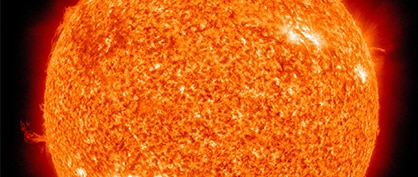
Amazing Science Facts
Discover each month new amazing science facts in our latest Lab Reporter issue.
January

It Can Rain Diamonds on Other Planets
According to American Scientist, the atmospheres of Neptune, Uranus, and Saturn contain atmospheres with such high pressure that they can crystallize carbon atoms and transform them into diamonds. We learned this scientific fact, but how? To demonstrate that this occurs on Neptune and Uranus, scientists were able to reproduce the necessary conditions in a lab. Separately, other experts hypothesize that Saturn's moons could get up to 2.2 million pounds of diamond rain annually.

Helium Can Also Work Against Gravity
Helium may flow without resistance when cooled to extremely low temperatures, which are only a few degrees above absolute zero (-460 F or -273 C). It has the ability to scale the sides of a glass and spill out through tiny breaches in a lid. It will never cease pouring once it begins to flow like a fountain. You call it a superfluid then.
February

And the Loudest Animal in the World is…
Either the sperm whale or the blue whale. It depends on how you define "loudest": do you measure the loudest animal by the decibels it registers or by the impact of the sound itself? According to the BBC, the sperm whale is perceived as louder than the blue whale. The call of a blue whale has a frequency of 20 Hz, the click of a sperm whale is 10,000 Hz. The volume of the sperm whale is 230 dB, that of the blue whale 188 dB. Such a volume could already kill us humans due to the sound pressure bursting the alveoli in the lungs.

6 Billion Tons of Stars in a Teaspoon?
The remains of a huge star that has ran out of fuel are known as neutron stars. While the dying star's core gravitationally collapses in on itself to become a super-dense neutron star, it also bursts into a supernova. Solar masses are used to measure the mind-bogglingly massive masses of stars and galaxies, with one solar mass equal to the mass of the Sun. Neutron stars typically have masses of up to three solar masses, making them some of the densest objects in the cosmos. A teaspoonful of neutron star would weigh 6 billion tons.
March

Cold Welding
Cold welding, also known as contact welding, is a solid-state welding procedure in which joining occurs at the intersection of the two components to be welded without fusion or heating. There is no liquid or molten phase in the junction, unlike fusion welding.
In the 1940s, cold welding became known as a widespread phenomena in materials. Then it was found that if two clean, flat surfaces of comparable metal were brought into touch while in a vacuum, they would strongly attach (see Van der Waals force). Cold welding at the newly discovered micro- and nanoscales offers potential for use in nanofabrication techniques.

Creating a Black Hole With Sound
Physicists have discovered that it is possible to create a massive black hole with sound. But that's no reason to worry, because a volume level of 1100 dB would be necessary to do this and the black hole that would then be created would be capable of destroying the entire universe. So why would anyone want to create such a black hole. You can find an explanation of how this black hole comes about here.
April

It Takes a Photon up to 40,000 Years to Travel From the Sun's Core to the Surface...
But only 8 minutes to make the rest of the way to Earth. A photon, on average, travels a certain distance before being briefly absorbed by an atom and emitted, scattering in new random directions. To travel from the core of the Sun to the surface of the Sun (696,000 kilometers) and escape into space, photons must make numerous drunken jumps.
The math is tricky, but the bottom line is that it takes a photon drunk thousands or millions of years to reach the surface of the Sun. In a way, some of the light that reaches us today is energy that was created millions of years ago. See the explanation here.

The Average Human Body has Enough DNA to Travel From the Sun to Pluto - 17 Times
The human genome (the genetic code for all human cells) contains 23 DNA molecules (called chromosomes), each containing between 500,000 and 2.5 million pairs of nucleotides. A DNA molecule of this size is 1.7 to 8.5 cm long when unwound, averaging about 5 cm. The human body has approximately 37 trillion cells. So if we roll up all the DNA trapped in each cell and position the molecules end to end, we have a total length of 2 x 1014 meters. This is long enough for his 17 round trips to Pluto (the distance from the Sun to Pluto). again 1.2 x 1013 meters). We should know that we share his 99% of his DNA with every other human being. See more information on human genome.
May

The Human Body is Mostly Bacteria: 10 Times More Bacterial Cells than Human Cells Found on Average
Isn't it funny how we go to great lengths to sanitize our surroundings and protect ourselves from germs, when in reality, our bodies are a thriving ecosystem of microorganisms? Believe it or not, if we were to collect all the bacteria living inside us, we'd have enough to fill up a half-gallon jug! And here's a mind-blowing fact: there are 10 times more bacterial cells in our bodies than human cells, as microbiologist Carolyn Bohach from the University of Idaho has pointed out.
Note that most of these bacteria are beneficial and crucial to our well-being. For example, they produce chemicals that help us break down and extract nutrients from our food. In fact, experiments with germ-free rodents have shown that they need to consume almost a third more calories than regular rodents just to maintain their weight. And when these same rodents were later exposed to bacteria, their body fat levels soared even though they didn't eat any more than they had before.
Moreover, our gut bacteria play a vital role in maintaining our immune system, underscoring the importance of taking care of our microbiome. So next time you feel the urge to reach for the sanitizer, remember that not all bacteria are bad. In fact, we owe our very survival to these tiny companions.

The Great Barrier Reef, stretching over 2,000 kilometers, holds the title of being the biggest living structure on our planet
The Great Barrier Reef is one of the most spectacular natural wonders of the world, and it is a source of national pride for Australians. This coral reef system is a living organism that is made up of over 2,900 individual reefs and around 900 islands, stretching for over 2,300 kilometers off the coast of Australia. It is the largest living structure on earth and is even visible from space.
It is home to an incredible array of marine life. It is estimated that there are over 1,500 species of fish, 600 species of coral, and numerous species of sharks, rays, turtles, and dolphins that call the reef their home. This diversity of marine life makes the Great Barrier Reef one of the most biodiverse ecosystems in the world. Aside from being an ecological wonder, the Great Barrier Reef is also a significant tourist attraction, bringing in millions of visitors and billions of dollars in revenue to Australia each year.
However, it is also facing significant threats. Climate change, pollution, and overfishing are all taking a toll on the health of the reef. Rising sea temperatures and ocean acidification are causing coral bleaching and other damage. These threats have led to significant declines in the health and diversity of the Great Barrier Reef in recent years, raising concerns about its future.
June

Discovering the Secret of Immortality: Turritopsis Dohrnii, the "Immortal
Jellyfish
Turritopsis dohrnii, also known as the immortal jellyfish, is a small species of jellyfish found in temperate to tropical waters worldwide. It is biologically immortal, capable of reverting to a sexually immature, colonial stage after having reached sexual maturity. The species begins its life as tiny, free-swimming larvae, settling to the sea floor and giving rise to a colony of genetically identical polyps.
The polyps then bud off into a free-swimming jellyfish form that eventually becomes sexually mature. If exposed to environmental stress, physical assault, or is sick or old, it can revert to the polyp stage, forming a new polyp colony through the cell development process of transdifferentiation. This theoretically can go on indefinitely, rendering the jellyfish biologically immortal, although individuals can still die.
The jellyfish is a target of basic biological, aging, and pharmaceutical research. Turritopsis dohrnii is found in temperate to tropical regions in all of the world's oceans, and it is believed to be spreading across the world through ballast water discharge.

New AI system can translate brain scans into words, offering hope for communication-impaired patients
A new technique based on artificial intelligence (AI) has been developed by computational neuroscientists that can translate brain scans into words and sentences. Using functional magnetic resonance imaging (fMRI), the non-invasive method tracks changes in blood flow within the brain to measure neural activity. The goal is to associate each word, phrase, or sentence with the particular pattern of brain activity that it evokes, which could eventually help individuals with brain injuries or paralysis regain the ability to communicate. Previous brain-computer interfaces (BCIs) have relied on electrodes implanted in the patient's brain, while non-invasive techniques based on methods such as electroencephalogram (EEG) have fared less well.
The new BCI based on fMRI taps more directly into the language-producing areas of the brain to decipher imagined speech. The system could someday aid individuals who have lost their ability to communicate because of brain injury, stroke, or locked-in syndrome, a type of paralysis in which individuals are conscious but paralyzed. However, that will require not only advancing the technology by using more training data, but also making it more accessible. The authors tested whether a decoder trained on one individual would work on another—it didn’t, but privacy is still a big ethical concern for this type of neurotechnology.
July

Honey Never Spoils
Did you know that honey is a truly extraordinary substance that never spoils? Archaeologists have discovered pots of honey in ancient Egyptian tombs that are over 3,000 years old and still perfectly edible. This remarkable fact showcases the incredible longevity and preservation properties of honey. Honey's ability to resist spoiling is due to several factors. Firstly, it has a low water content, typically around 17%, which inhibits the growth of microorganisms. Additionally, honey has a high sugar concentration, which creates an inhospitable environment for bacteria and other potential spoilage agents.
Lastly, the acidic pH of honey, usually between 3 and 4, further prevents the growth of harmful organisms. Throughout history, humans have valued honey not only for its delightful taste but also for its potential medicinal properties and long shelf life. Its antimicrobial properties have made it a natural remedy for various ailments, and its ability to remain unchanged over extended periods has made it a valuable food source in many cultures. So, the next time you enjoy a spoonful of honey, remember its incredible longevity, a testament to the unique and fascinating properties of this sweet and golden nectar created by bees.
August

Oceanic Oxygen: The Vital Source of Life on Earth
The ocean plays a crucial role in producing oxygen and is often referred to as the "lungs of the Earth." The majority of Earth's oxygen actually comes from marine plants, specifically phytoplankton, algae, and seaweed, through a process called photosynthesis. These microscopic organisms produce oxygen as a byproduct of converting carbon dioxide and sunlight into energy. While it is challenging to determine an exact figure, it is estimated that marine plants are responsible for producing about 50% of the oxygen in Earth's atmosphere. The remaining oxygen comes from land-based plants, particularly trees and forests. Therefore, both marine and terrestrial ecosystems contribute significantly to the oxygen supply on our planet.
It's important to note that the oxygen produced by marine plants does not directly escape into the atmosphere but rather dissolves in the ocean. However, the oxygen-rich waters eventually mix and exchange gases with the atmosphere, ensuring a balance between oxygen production and consumption. Protecting and preserving the health of the oceans is crucial not only for marine life but also for the overall oxygen production and the well-being of our planet.

Venus: Where a Day Outlasts a Year in a Cosmic Twist!
Venus has a very slow rotation, taking approximately 243 Earth days to complete one full rotation on its axis. This means that a day on Venus (the time it takes for one complete rotation) is longer than a year on Venus (the time it takes to orbit the Sun).
In contrast, Venus takes approximately 225 Earth days to complete one orbit around the Sun. Therefore, a year on Venus (the time it takes to complete one orbit around the Sun) is shorter than a day on Venus (the time it takes for one complete rotation).
This unique characteristic of Venus, where its day is longer than its year, is due to its retrograde or backward rotation. It is one of the reasons Venus has complex and unusual patterns of day and night cycles compared to other planets in our solar system.
September

Time Dilation: Unveiling the Secrets of Relativity - How Speed Alters the Flow of Time
Albert Einstein's revolutionary theory of relativity has brought to light the mesmerizing concept of "Time Dilation". It's like a page from a sci-fi novel, but it's been proven in experiments. Imagine this: as an object approaches the speed of light, time for that object begins to slow down relative to a stationary observer. It's as if time itself is playing tricks on us, revealing the intricate interplay between motion and the fabric of the universe. From high-speed airplanes to cosmic spaceships hurtling through space, atomic clocks have confirmed this intriguing phenomenon. Get ready to have your mind blown as we delve into the remarkable world of time dilation, where motion changes the very flow of time.

The Immensity of Our Galaxy: Counting Stars in the Vast Ocean of the Milky Way
Step into the grandeur of the Milky Way, our magnificent home in the cosmos. With an astounding 100-400 billion stars, the Milky Way is a celestial masterpiece that defies our imagination. Picture this: If you dared to embark on the epic quest of counting every single star in our galaxy, one star per second, your journey would span over 3,000 years! The sheer vastness of the Milky Way humbles our human perspective, yet it's just a single starry island in the cosmic sea.
Explore the awe-inspiring scale of our universe, where galaxies abound, each with its own dazzling array of stars and planets. It's a cosmic adventure that will leave you marveling at the immense beauty and boundless wonders that the universe has to offer.
October

The Electrifying Power of Lightning: Nature's Spectacular Display
Lightning, a breathtaking display of nature's raw power, has captivated human imagination for millennia. It's a celestial ballet of electric charges, a fleeting drama that momentarily transforms the night sky into a radiant spectacle. Yet, behind its dazzling appearance lies an astonishing force that defies comprehension. A single lightning bolt carries an immense energy payload. When it strikes, it heats the air around it to temperatures hotter than the surface of the Sun. Imagine the atmosphere suddenly igniting into a blinding inferno, a transient burst of energy that leaves its mark on the landscape.
But what creates this awe-inspiring phenomenon? Lightning forms within thunderstorms, where updrafts and downdrafts cause ice particles to collide, generating electrical charges. The Earth itself is electrically charged, with a negatively charged surface and a positively charged upper atmosphere. When the charge separation becomes too great, it seeks a path to equalize, and lightning is born. The result is a dazzling discharge, with branching tendrils of electricity racing toward the ground. The intense heat generated by lightning causes the surrounding air to expand explosively, creating the sonic shockwaves we know as thunder. In an instant, a tranquil sky transforms into a tempestuous theater of light and sound.
Beyond its aesthetic allure, lightning plays a vital role in our planet's electrical balance. It helps distribute electrical energy across the Earth's surface, which is crucial for maintaining the electrical neutrality of the atmosphere. The phenomenon of lightning reminds us of the incredible forces at play in our natural world. It underscores the importance of understanding and respecting the power of nature. While we marvel at its beauty and power, we must also remember that, for all its splendor, lightning can be a formidable and sometimes destructive force, serving as a reminder of our place in the grand scheme of Earth's systems.
In the end, lightning remains one of nature's most captivating displays, a fleeting and electrifying reminder of the remarkable forces that shape our planet and the universe beyond.

The Enigmatic Fourth State: Exploring the World of Plasma
In the realm of science, where the familiar states of matter—solids, liquids, and gases—once reigned supreme, a mysterious and electrifying fourth state emerged, challenging our understanding of the physical world. This extraordinary state is known as "plasma." Often referred to as the "fourth state of matter," it is unlike anything encountered in everyday life. It is a captivating blend of chaos and beauty, where matter transforms into a swirling, electrically charged dance. Lightning bolts, the fiery radiance of stars, and the vivid hues of neon signs all owe their existence to this exotic state.
At its core, plasma consists of ions and electrons—positively and negatively charged particles—freely moving and interacting with one another. It's as if the particles have shed their rigid identities as solids, the fluidity of liquids, and the random jostling of gases, to embrace a dynamic, electrifying freedom. Plasma's most remarkable attribute is its capacity to conduct electricity with unparalleled efficiency. In the sun, where temperatures soar to millions of degrees, plasma reigns supreme, facilitating the nuclear fusion reactions that power the star's brilliance.
But plasma's influence extends far beyond celestial realms. It plays a critical role in the fluorescent lights that brighten our cities, the plasma TVs that entertain us, and the fusion experiments that hold the promise of clean, limitless energy for our future. Despite its ubiquity in the universe, plasma remains a challenge to study and harness on Earth. Containing and controlling this electrifying state is a formidable task, one that scientists continue to tackle in the pursuit of breakthroughs in energy generation, space exploration, and beyond.
The emergence of plasma as a recognized state of matter reminds us that the universe is a treasure trove of secrets waiting to be uncovered. It stands as a testament to human curiosity and innovation, as we venture into the enigmatic world of the fourth state and harness its astonishing power for the betterment of our world.
November

The Sun's Radiant Power: A Stellar Enigma
The Sun, a celestial body that has captivated humanity for millennia, holds a remarkable secret within its fiery core. Its awe-inspiring luminosity and life-giving warmth are not mere happenstance but rather the result of an immense release of energy. The Sun's radiant power, derived from the process of nuclear fusion, is a testament to the remarkable forces at work in the heart of our solar system. At the core of the Sun, temperatures soar to mind-boggling heights, reaching approximately 15 million degrees Celsius (27 million degrees Fahrenheit). In this extreme environment, hydrogen atoms collide with such tremendous force that they combine to form helium through a process called nuclear fusion. This fusion reaction releases an extraordinary amount of energy, transforming mass into pure radiance.
The Sun's energy output is staggering. In a single second, our star unleashes an astonishing amount of energy, surpassing the cumulative energy consumption of humanity throughout history. This prodigious release of energy sustains life on Earth, providing warmth, light, and nourishment to all living organisms. The Sun's radiant power is not solely a consequence of its immense size. Although the Sun is about 1.3 million times larger than Earth, its density is relatively low. This characteristic, combined with the intense heat and pressure at its core, allows the nuclear fusion process to occur. It is this delicate balance of temperature, pressure, and density that enables the Sun to sustain its radiant power.
The Sun's energy journey is a remarkable one. From the core, photons, or particles of light, are born. These photons then embark on a long and arduous journey through the Sun's dense layers, slowly making their way to the surface. As they rise, the photons are repeatedly absorbed and re-emitted by the surrounding plasma, a process that can take thousands of years. Eventually, the photons reach the Sun's surface and are released into space, racing across vast distances to reach Earth in a mere eight minutes. The Sun's radiant power is a testament to the marvels of the universe. Through the intricate dance of nuclear fusion, the Sun transforms matter into pure energy, radiating warmth and light across the cosmos. Its energy sustains life on our planet, shaping our climate, nurturing ecosystems, and fueling the processes that drive our world. As we gaze upon the Sun, we are reminded of the incredible forces that shape our existence and the profound interconnectedness of all things in the vast expanse of space.

The Antarctic Ice Sheet: A Giant Frozen Reservoir with Global Implications
The Antarctic ice sheet is a vast, frozen expanse that has captivated the imagination of scientists and the world at large. This colossal ice sheet, located at the southernmost tip of our planet, holds a staggering 90% of the world's ice. Its sheer magnitude and influence on our planet's climate make it a subject of critical concern and study. Remarkably, it contains enough water to raise global sea levels by approximately 60 meters (197 feet) should it melt entirely. In this essay, we will delve into the significance of the Antarctic ice sheet, the factors contributing to its stability, and the potential consequences of its melting.
The Antarctic ice sheet is a true natural wonder, encompassing an area of over 14 million square kilometers. It is divided into two main components: the East Antarctic Ice Sheet, which is larger and generally more stable, and the West Antarctic Ice Sheet, which is notably more vulnerable to warming temperatures. The ice sheet is composed of snow, compacted over millennia, forming layers of ice that can be several kilometers thick. This icy behemoth plays a pivotal role in regulating the Earth's climate. It reflects sunlight, helping to cool the planet, and it stores an incredible amount of fresh water. The ice sheet's significance extends far beyond the polar regions, as it directly impacts global climate patterns and sea levels.
The Antarctic ice sheet's stability is largely maintained by a delicate balance of processes. Several key factors contribute to its resilience:
- Low Temperatures: The extreme cold of Antarctica helps preserve its ice. The continent's interior experiences some of the coldest temperatures on Earth, which inhibits the natural processes of ice melting and calving.
- High Elevation: Much of the ice sheet is situated at high elevations, where temperatures are even lower. This elevation acts as a natural barrier against the influence of warmer air masses.
- Thickness: The immense thickness of the ice sheet insulates the ice beneath, preventing rapid heat transfer to the base.
- Sea Ice Shield: Sea ice surrounding Antarctica acts as a protective shield, limiting the interaction between the ice sheet and the warming ocean.
December

Scientists Unveil Elusive Isotope: Nitrogen-9's Secrets Revealed
A recent article titled "Physicists get a first glimpse of the elusive isotope nitrogen-9" discusses a breakthrough in the field of physics. The researchers claim to have observed the isotope nitrogen-9, which has been challenging to detect and study due to its short lifespan.
The researchers were able to create and observe nitrogen-9 by colliding a beam of helium nuclei with a target made of beryllium. This collision produced a variety of particles, including the elusive nitrogen-9. The team used advanced detectors to identify and measure the properties of the particles produced in the collision.
The discovery of nitrogen-9 is significant because it provides insights into the behavior of atomic nuclei and the fundamental forces that govern them. It also contributes to our understanding of nuclear reactions and the synthesis of elements in the universe.
However, the claim made by the researchers has faced scrutiny and controversy. Other scientists in the field emphasize the importance of reproducibility and independent verification of the results. The ultimate test of this discovery will be whether other researchers can confirm the existence of nitrogen-9 through their own experiments.
This breakthrough opens up new possibilities for studying and manipulating atomic nuclei, which could have implications in various fields including nuclear physics, astrophysics, and materials science. Further research and experimentation will be necessary to fully understand the properties and behavior of nitrogen-9 and its potential applications.

Quantum Mechanics Revolutionize Engine Technology: A Glimpse into Fuel-Free Propulsion
In a recent development, as reported in "Nature," physicists led by Jennifer Koch at the Rheinland-Pfälzische Technische Universität Kaiserslautern-Landau have introduced a groundbreaking quantum mechanical engine. Unlike traditional engines, this quantum motor operates based on fundamental quantum properties of particles, eliminating the need for fuel ignition.
The engine leverages the distinction between fermions and bosons, two categories that encompass all known particles. While fermions, such as electrons and quarks, avoid sharing the same quantum state, bosons, like photons and gluons, tend to cluster together in the lowest energy state. The Pauli Exclusion Principle governs the arrangement of electrons within atoms, as it prohibits two identical fermions from occupying the same quantum state.
Koch and her team exploited the unique behavior of these particle families. By cooling a system of fermions to an extremely low energy state, the particles, due to the Pauli Principle, form a tower-like structure with varying energy levels. The researchers then paired these particles, transforming them into bosons. This transition allowed all pairs to occupy the lowest energy state, as the Pauli Principle no longer applied. This conversion released energy that could be harnessed to power a quantum motor.
In their laboratory experiments, the team cooled lithium atoms, fermions, to just above absolute zero, creating particles with energy proportional to the square of their number. By coupling the atoms with a magnetic field, they formed pairs that acted as bosons, resulting in a significantly lower energy level, only proportional to the number of particles. The team could reverse this transition by adjusting the magnetic field. This quantum mechanical engine demonstrated 25% efficiency.
While practical applications remain distant due to specific experimental conditions, this research showcases the theoretical viability of a quantum mechanical engine. With larger ensembles of particles, the efficiency gains hold the promise of future quantum-powered systems.